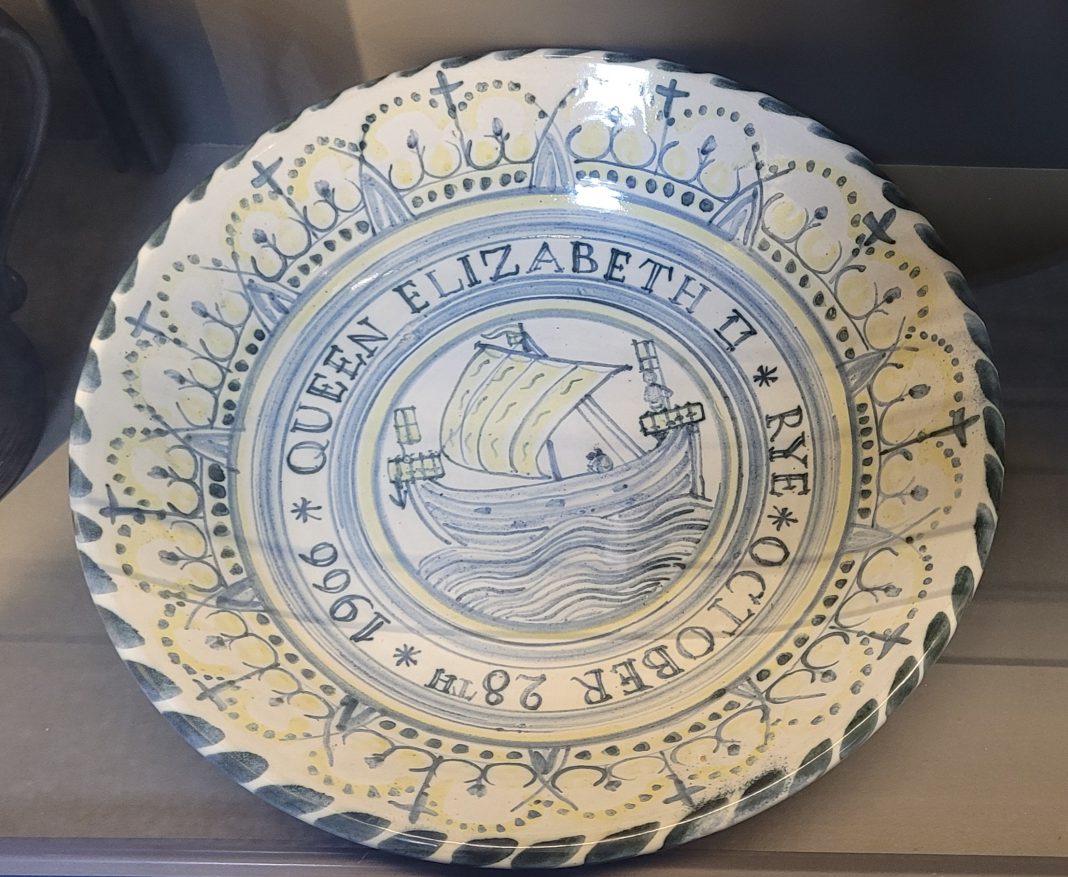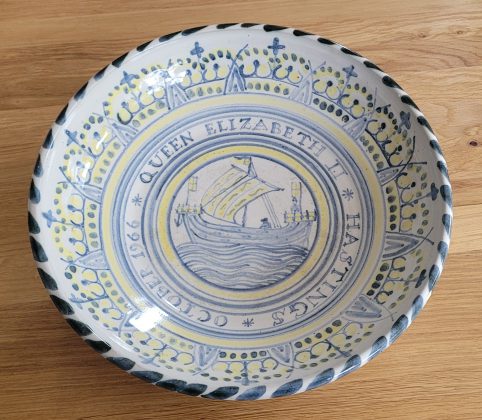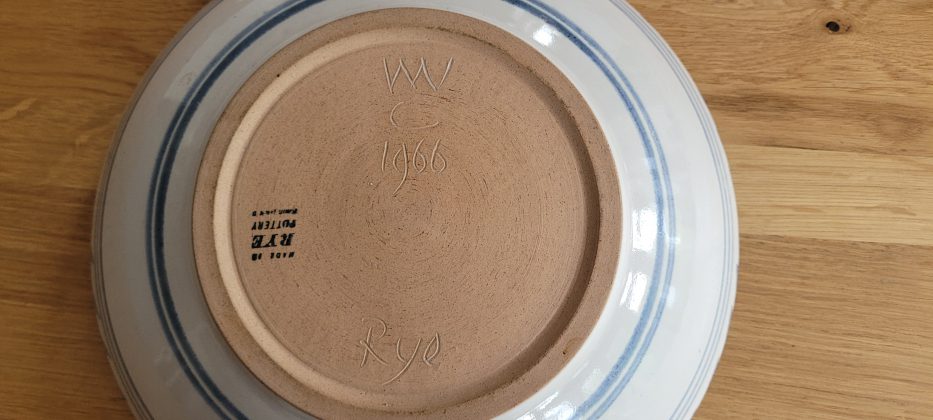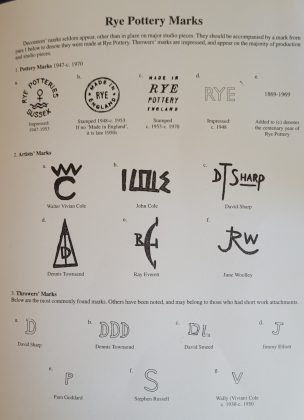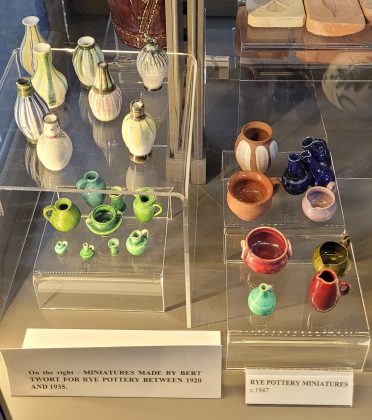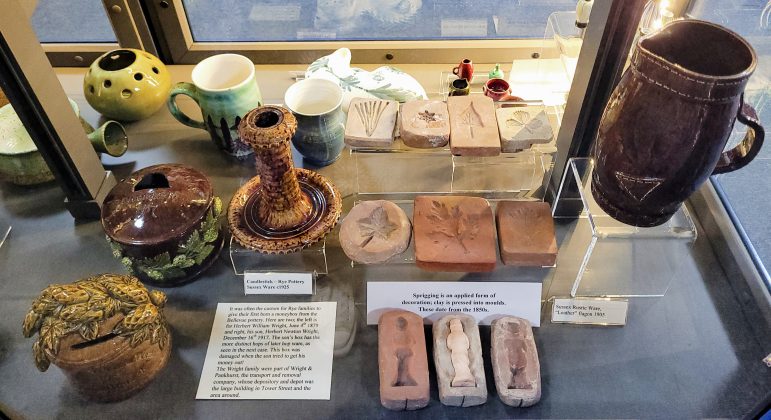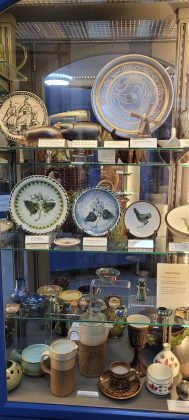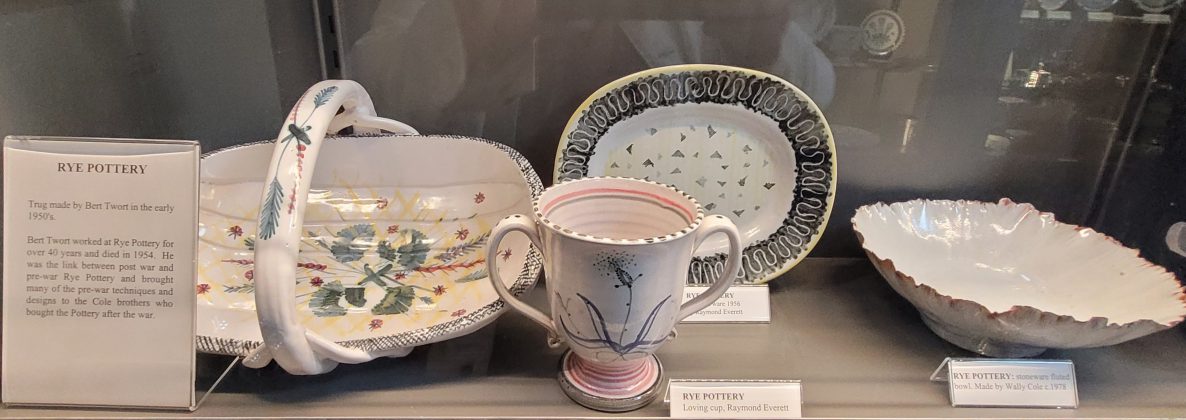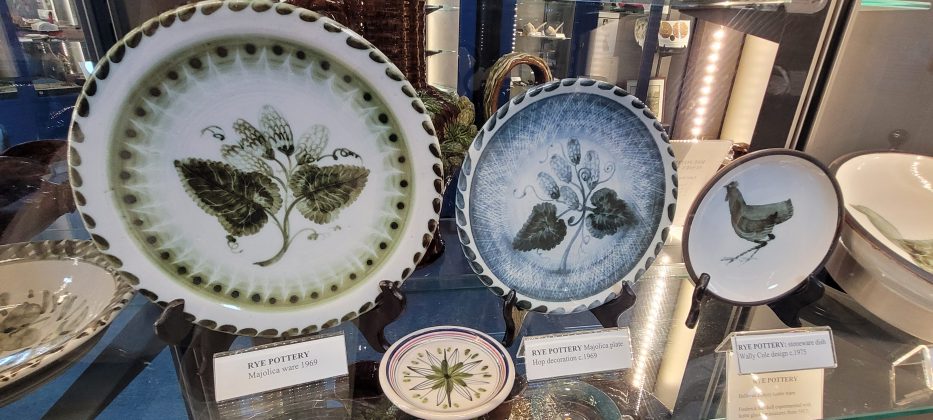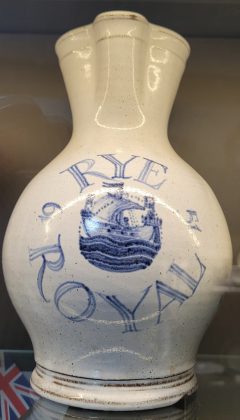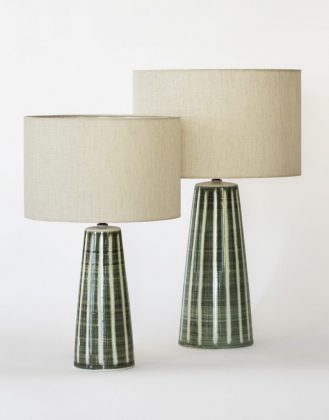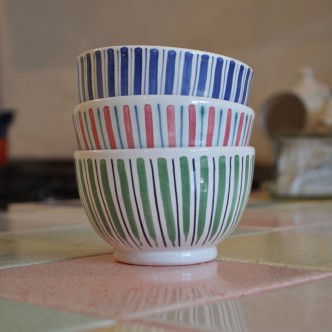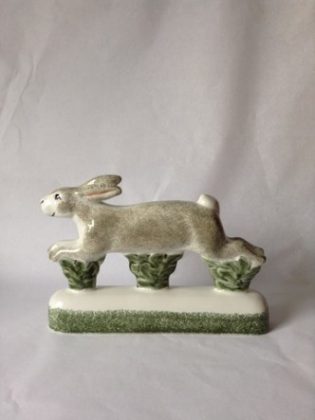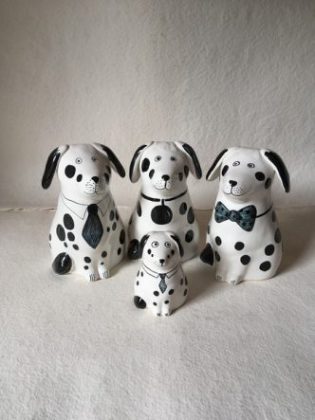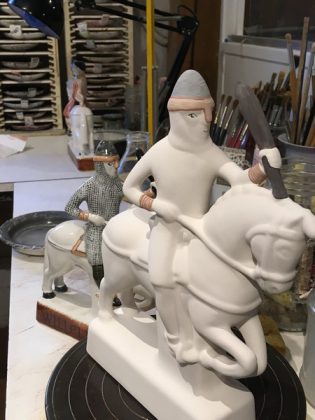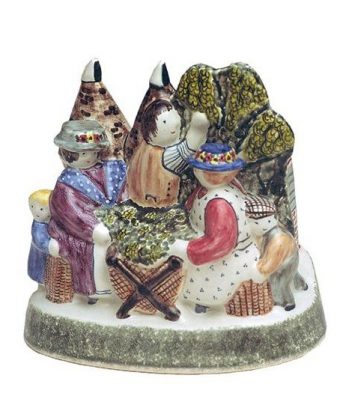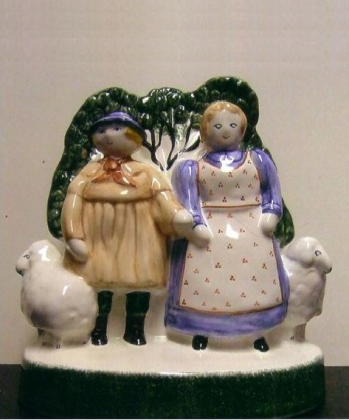This is the second in a series of articles in which people involved with the Rye Castle Museum choose an object from the collection that represents an aspect of the history of the town, and its environs, and tell us what it means to them.
The Rye Pottery Queen Elizabeth II 900th anniversary of the Battle of Hastings commemorative plate of 1966
On October 28, 1966, Queen Elizabeth II visited Rye as part of the celebrations of the 900th anniversary of the Battle of Hastings and, to commemorate the event, Rye Pottery produced a limited number of mugs, plates and bowls, one of which is in the Rye Castle Museum. As well as visiting Rye, on that day, the queen went on to visit Winchelsea, Hastings and Eastbourne.
Stephen Masters, a director at Rye Castle Museum has chosen this museum object as he remembers a very similar version made by Walter (Wally) Cole, whose initials appear on the base, produced to commemorate the Queen’s visit to Hastings that day.
“I inherited the Hastings version of this dish from my grandmother, and it is one of my favourite items. I remember that bowl being used as a fruit bowl in the flat she shared with my great aunt, and great uncle in Grosvenor Crescent, St Leonards-on-Sea from the mid to late 1960s.
“Seeing another version in the East Street Museum was a lovely surprise. I hadn’t realised that a series of these bowls had been made by Rye Pottery.
“The bowl brings back happy memories of visits to my family in Grosvenor Crescent. I spent many holidays there, and even lived with them for a period. Having recently moved back into the area completes that circle.”
Potteries in Rye
There have been potteries in Rye since the medieval period, due to the clay soil found around Rye which was ideal for making pottery. In addition, the nearby river and sea meant that goods could be transported easily and later, in the 18th and 19th centuries, when hops were grown in Sussex, the tall wooden hop poles were a good source of wood to fire the kilns.
Cadborough Pottery
Rye Pottery has its origins in 1793 at Cadborough Farm, where bricks and glazed terracotta domestic ware was produced using local red clay from the farm. It was established by James Smith and then run by his son, Jeremiah Smith, who became one of the largest hop-growers and sheep farmers in Sussex in the first half of the 19th century. In 1830 he made William Mitchell the manager and William later bought it in 1840, running the pottery with his sons, Henry and Frederick.
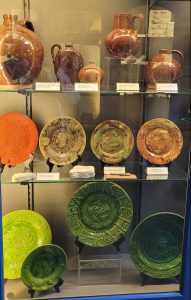
While William had experimented with different clays, Frederick was more interested in using different glazes and applied decoration and so began producing pots adorned with acorns, hops flowers and leaves with brown or green glazes, known as hop-ware or rustic ware.
Bellevue Pottery
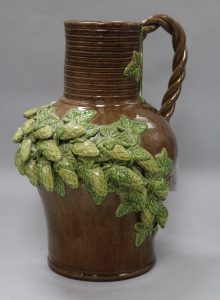
In 1868, Frederick Mitchell built a house and pottery on a plot of land in Ferry Road and established the Bellevue Pottery along with his brother, Henry and potter, William Watson. Bellevue was run by Frederick Mitchell until his death in 1875 and then by his wife, Caroline, along with William Watson and his nephew, Frederick Thomas Mitchell. It continued to produce and refine the hop-ware and pots decorated with oak leaves, grapes or flowers, as well as the Sussex moneyboxes and Sussex pigs (see below) that had been produced at Cadborough. Under the ownership of Edith Mitchell and then Ella Mills, the range expanded to include lustre glazed items, miniatures, and other smaller items. With the outbreak of the second world war, the pottery closed as the kilns were no longer allowed to fire at night.
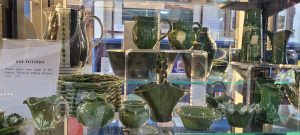
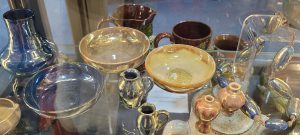
Rye Pottery
In 1947, Bellevue Pottery was re-opened as Rye Pottery by two brothers, John (Jack) and Walter (Wally) Cole who had both trained in sculpture and ceramics pre-war, making one-off studio pieces selling at high prices in London art galleries. They now wanted to create more affordable, well-designed, handmade pottery for the post-war era.
The Coles kept some of the traditional designs of the Bellevue but introduced the Faience or Majolica technique of 17th century English and Dutch Delftware using white tin glaze decorated with their own simple brushstroke decoration and brighter colours. John and Wally were keen to keep a link between the earlier Rye potteries and their own more modern vision and achieved this through the help of Bert Twort who had worked with the Mitchells.
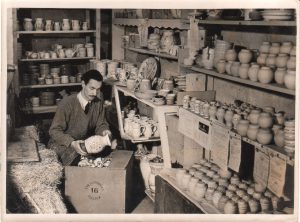
Wally was responsible for creating the ceramics and running the pottery while John made the designs and created the patterns and decorations. As their work became increasingly popular, the Coles began to employ and train other staff and soon the throwers David Sharp, Dennis Townsend, Raymond Everett, David Smeed and Jim Elliott, and decorators Pam Goddard, who later became a thrower, and June Woolley joined.
At first, Rye Pottery used local red clay, often dug by Wally from the top of Rye Hill and tan clay, dug from the marshes near Harbour Road. The local clay was mixed with Devon ball clay which was very plastic. The mix was needed as the marsh clay had a high salt content which could cause the clay to melt in the high temperature of the kiln.
Then, just as now, the thrown clay was fired before any decoration was applied (after this firing it is known as biscuit ware). The biscuit ware was then covered in the tin glaze and colour decoration was applied, after which it was fired again.
In 1951, five pieces of Rye Pottery were shown at the Festival of Britain, and from the 50s through to the 70s the pottery produced lines including jugs, bowls, mugs, loving cups, and dishes of many designs. In the mid-50s the pottery became well-known for its sgraffito textures. This was a method of applying colour all over the glaze which was then scratched to reveal the white glaze beneath. Contemporary interpretations of these original designs are still produced today.
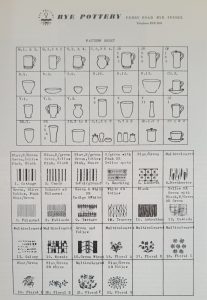
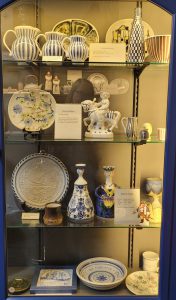
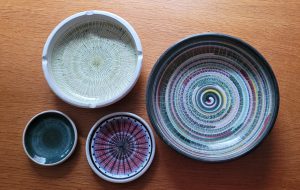
Through the 60s and 70s, Rye Pottery produced series of whole tableware ranges including the Cadborough range (which used a manganese glaze) and the multi-coloured floral sets. Commemorative plates and mugs were popular throughout Queen Elizabeth’s reign.
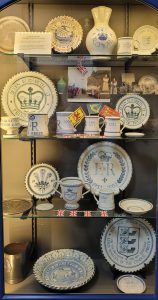
In 1978, Wally Cole retired and Tarquin, along with his wife Biddy, took over running the pottery overseeing all areas of the creative process and designing many of the pieces. The impact of the miners’ strike and competition from overseas manufactured tableware meant that the Coles had to change direction, producing a range of collectable figures and animals. Characters from the Canterbury Tales designed by Tony Bennett continue to be produced along with his 1066 Bayeux Tapestry, Battle of Hastings series. Other designers, past and present, include Neal French, Chris O’Donoghue, Gordon Davies, Joan de Bethel and Wendy Johnson. In addition to running the pottery, Tarquin had already established his own company in the early 1960s, Rye Tiles, and the present-day pottery still produces these using many of his original designs.
The Sussex Pig
No history of Rye Pottery is complete without mention of the famous Sussex Pigs, first made at Cadborough and which continue to be produced at Rye Pottery today. Pig Tales – A new short film about Rye Pottery’s iconic Sussex Pig by Alisdair Kitchen, details the creation of this traditional Sussex wedding gift. Beautifully shot, it shows the love and care taken in making and painting the ceramic pigs by hand.
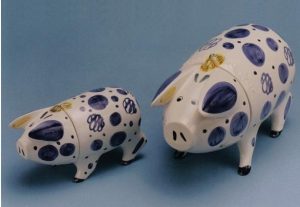
Rye Pottery today
We can be grateful that under the enthusiastic direction of the third generation of Coles, Tabby and Josh, Rye Pottery continues to produce beautiful handmade pottery using 17th century decorative techniques, freehand brushwork, and the distinctive Rye Pottery colours. As well as modern tableware and homewares, 18th century figures, English animals and birds and the Canterbury Tales or The Bayeux Tapestry 1066 collections, the pottery’s celebrated mid-century modern collections are still much sought-after today.
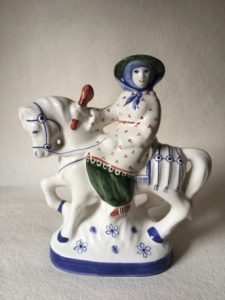
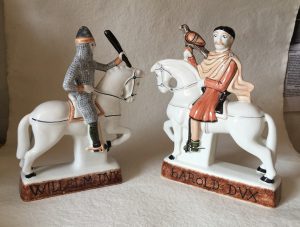
As Stephen Masters puts it: “Having a piece of the acclaimed Wally Cole’s pottery is very special. Rye Pottery has been a very important part of Rye’s artistic and manufacturing history. There are other pieces on show at the East Street Museum reflecting the different styles through the years but Rye Pottery, being run by the third generation of the Cole family, continues to keep Rye very much in the forefront of pottery design.”
We certainly are lucky to have it!
The Rye Castle Museum article called Rye Pottery: nearly 250 years of collectability is a good read for those wanting to find out more about how the craft developed in Rye over the years.
Carol Cashmore’s “The Potteries of Rye 1793 onwards” is a detailed and interesting history of the potteries of Rye up until 1980s.
Image Credits: Juliet Duff / Rye Castle Museum , Juliet Duff/Rye Castle Museum , Robin Wilson , Rye Pottery , Juliet Duff .



